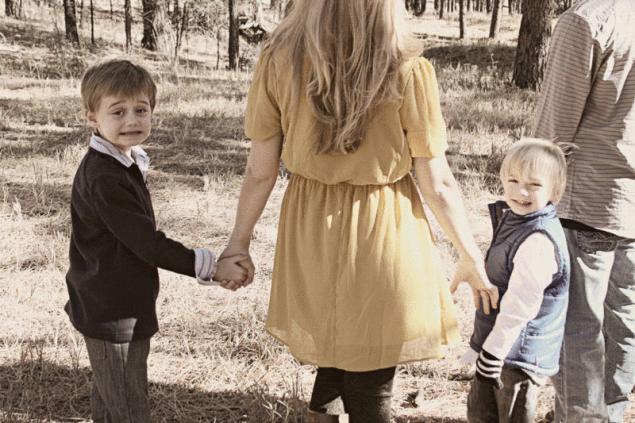396
The patchwork family: Children from old marriages and new relationships

The modern family is not always a “classic arrangement”: mom, dad and their children. The inconstancy of marriage unions and the change in public attitude to the institution of marriage as such lead to the fact that more and more families appear, where partners “come” to a new family with children from a previous marriage, forming motley mixed families. However, the time of angry stepmothers and inhospitable stepfathers is already in the past. Today, such non-standard families are affectionately called patchwork families. And, according to many researchers, behind these "patchwork families" - the future.
Why patchwork?
The concept of a family in the style of patchwork comes from the English “patchwork-family” and is an analogy between the type of needlework (patchwork – patchwork sewing) and newly created families, where for partners it is most often a second marriage and there are children. Thus, the new family is like a bright patchwork blanket “stitched” from the numerous fragments of previous marriages and unions. In the Russian typology of modern families such families are called mixed.
Patchwork families exist in various variations: families with a stepmother or stepfather who do not have their own children; families where both parents have children from previous unions; families where, in addition to children from past marriages, joint children were born; families where children live permanently or only come for a while, etc. In total, scientists count more than 70 possible combinations of patchwork families. That’s where the really “patchwork family” fully justifies its name. However, it is this diversity and complexity of relationships between specific members of the new motley family that provides a considerable number of almost inevitable conflicts.
The emergence of patchwork families
A hundred years ago, the main path that led to the formation of a mixed family in the style of patchwork was the death of one of the spouses. Widows and widowers needed a new soul mate not so much because of feelings of loneliness or beliefs that “a child needs a full family”, but for more mundane reasons. It was often impossible to feed the children alone, and a widower without a “woman’s hand” could not cope with the house. Now, thanks to medical progress, the probability of death of one of the spouses at a young age has decreased significantly. The number of divorces, on the contrary, has increased. And, although the society has long been not so harshly condemned single mothers and “dads on the weekend”, after parting with one partner, many are actively looking for a new half.
According to current statistics, 52% of marriages in Russia end in divorce. Not surprisingly, many divorced people are trying to find their new happiness and try to start a new family. In Germany, the situation is very similar to the Russian one: every second marriage breaks up within the first seven years. However, unlike Russia, more than half of divorced moms and dads find a new partner within the first year. Although there are no official statistics on patchwork families, researchers estimate that almost 30% of German children have lived or had temporary experience in such mixed families in the past two decades, and patchwork families (albeit with not always formalized relationships) are almost the “norm” for this European country. It is not surprising that sociologists and psychologists did not ignore the study of relationships and the influence of this form of family relations on the process of upbringing and the psychological state of children.
New happiness at the expense of children?
The first difficulties of mixed families arise just when a new partner is found. Many single parents are convinced that their children will accept a new family member (or family members) with open arms. One of their main desires is to give their children the opportunity to live in a full-fledged family again! However, it is for children to accept a new member of the family instantly “as a native” is at least difficult, and sometimes impossible, primarily because they already have the same “native” (read – biological parent). For most children, returning to normal means reuniting their parents and returning to the old way of life in the family. And if this is not possible, then at least you do not have to share your mother or father with “aliens”, she (he) should remain at their full disposal. In this case, the appearance of a completely new person in the child’s life is a certain point of no return, crossing which they agree that since there will never be before.
Therefore, a child’s first natural reaction to a “reserve” parent is rejection, neglect, or open conflict. Only time and joint efforts of new spouses can overcome this period. At the same time, the age of the child plays a dominant role in the process of getting used to and adopting a new form of family. Psychologists distinguish several age categories that experience mental restructuring in different ways: infants under 2 years old, preschool children from 2 to 6 years old and children over 6 years old.
For infants and young children under two years of age, the most important thing is that they still have a mother (as the main link between the outside world and the world of the child) or a person who replaces her (that is, having the same degree of attachment to the child according to Bowlby). In this case, the child is relatively easy to endure a break with the other parent. In addition, a new partner can quickly win the favor of the child, paying him due attention (both quantitatively and qualitatively).
Children of kindergarten age endure family reforms much more difficult. At this age, they tend to think that they are the cause of what is happening around them, so they often come to the conclusion that they are “guilty” for the changes that occur. Typical for this age are the logical chains “I wasn’t obedient enough, so mom and dad don’t live together anymore,” etc. As a result: guilt in the child, a vivid negative reaction to a new family member, outbursts of anger, rage, jealousy or grief. The main task of the new parent is not to perceive the emotional outbursts of the child as a protest against his personality, but to remember that these emotions are only a protest against the attempt to take the role of the departed parent. Children under the age of 6 usually take time to get through the changes that are taking place, accept the parental gap and accept a new family member.
Adaptation to a new form of family is most difficult in the category of children older than 6 years. Often, they suffer from conflicting feelings that prevent them from accepting a new parent (even if he is much better, more attentive and caring), as this will mean “betrayal” towards their own father or mother who no longer live together. Therefore, psychologists recommend in this case, first of all, to allow children and adolescents to keep the desired distance. The new parent should not spend every effort from the first days to gain trust or try to replace the absent parent by 100%, as well as not be offended by the child if he openly demonstrates coldness and distances himself from joint activities. The best way out is to find common interests with the child, which will not duplicate the previous parental activity (i.e. if the native father liked to take his son fishing, then the “spare” dad can choose the child’s favorite sport as a “key” to mutual understanding).
Dad with many children in one day
From the parent bell tower, the sudden appearance of new children and the restructuring of family life is also not easy. The most difficult is for those who did not have children at all, and then suddenly you have to take care of, for example, two teenage children at once. Or a young mother, accustomed to give all her attention to an only child, in an instant becomes a mother of many children and is forced to give attention and care to a large sheep at once. In these cases, only time and willingness to discuss emerging difficulties, misunderstandings and problems at the family council will help. Especially as regards the methods of education and the designation of boundaries (or their absence) in the matter of “my children”. Keeping the balance between “our” and “other” children in matters of upbringing is a subtle art that comes only with time and often through trial and error.
Another important aspect is the legal aspect. If the relationship between the spouses is regulated by ordinary family law, then the issue of legal relations with the children of the “new half” is a gray area. On the one hand, without the fact of adoption, the new father or mother does not have the right to make decisions regarding the “not their own” child, since they are not his official legal representative. This means that, in fact, the “new” parent may not even give a child from kindergarten or refuse to visit a sick child in the hospital. To do this, you need to obtain the appropriate paper – a power of attorney on behalf of biological parents. Although unlike many European countries, where legal issues are observed meticulously, in Russia, such things are often looked at through the fingers. Basically, a teacher doesn’t care who brings a child to school, picks him up, or who comes to a parent meeting. Many people are simply not aware of their family situations. However, it is not always possible to resolve the “legal issue” through the adoption process, even if there is a desire. This refers to situations where the biological parent is not deprived of his legal rights in relation to the child or actively participates in his life.
Benefits of a mixed family--vid1-- If the creation of a new motley cell of society involves so many problems, does it make sense at all? What are mixed families so good about, apart from meeting the needs of new spouses? The advantages for children in patchwork families are no less than the difficulties.
On the one hand, a new development-friendly atmosphere is created around children, new reliable people (adults) appear, with whom one can take an example or turn for support or protection, receive the missing attention and affection. On the other hand, the more members there are in a new family, the faster and better the child’s social competencies develop. Such everyday skills as the ability to share toys, goodies, parental attention with brothers and sisters, joint games, the ability to find compromises, respect for the personal zone of another person - all this can be a novelty for a child who was previously the only center of attention. It is not surprising that children from patchwork families quickly and willingly establish social contacts then in kindergarten, school and life in general. In harmonious relationships with brothers and sisters, even if not by blood, children from patchwork families get friends and reliable companions for the rest of their lives.
“Pachwork” – family style of the 21st century?
Many researchers, sociologists call patchwork families family model of the future, which will continue to gain popularity. In patchwork families where relationships are already established, it is often impossible to determine from the outside whether a given family is patchwork or classic, then leads to full acceptance of such a family by the environment. Children who grew up in mixed families perceive this model as the norm. At the same time, other alternative models of family relations (for example, a single parent with children or same-sex unions with the biological children of one of the partners) do not have such prospects, as they require more strength to combat social stereotypes. It is impossible to speak of patchwork families as a panacea of the institution of the family, because at the heart of each new patchwork union are fragments of failed marriages, leaving an invisible but significant psychological trace.
Can mistakes be avoided? The golden rule of patchwork family is that understanding takes time and patience. If members of a new family expect too much too quickly, mistakes and disappointments are inevitable. So, after moving a new partner, and possibly his children, the first task of adults is to gradually and carefully introduce new people to the established home life. The ideal option is when before the final move, a new family tries to live “in a new way”, arranging from time to time a joint weekend with overnight stays or outings in the city.
In a new relationship, it is important for adults to remember three basic principles. First, don’t expect a child to fall in love with a new parent spontaneously, even if they do their best to do so. Second, only after a trusting relationship has been built between the child and the new parent can he begin to take care of him and especially participate in the educational processes. Third, even if your child doesn’t like the new family member at all, you should explain to them that they should be treated politely and respectfully like any other adult. One of the popular mistakes of new moms and dads is that they try not only to replace the biological parent, but also to be better at everything: more attention, more care, more understanding, etc. At the same time, it is much more difficult for stepmothers to implement such plans than for stepfathers. Firstly, the bad image of the “evil stepmother” from social stereotypes affects. And secondly, the psychological bond between the child and the mother is usually so strong that an attempt to occupy a “sacred place” can be regarded as a declaration of war. The easiest way to get your children’s affection is to try to be a friend. Remember, for real parents, a place is always reserved in the soul of a child, even if this parent has long been absent from the life of the offspring and was previously known as a very bad father or cuckoo mother.
Family as a joint creation
Managing a large family is not an easy task, both in educational and household terms. What is only a matter of logistics for the delivery of children to school, kindergarten or other mandatory events. Or the question of taking into account the interests of each of the family members, when choosing a type of rest or a menu for the holiday. It is logical that in a patchwork family to sit at the “table of negotiations” between parents and children is more often, the better. Each of the members of the new family brings with them the experience, disappointments and prejudices from the previous union, so keeping quiet about exciting problems and “slippery” topics is a direct road to a new breakup.
Together with children, it is worth discussing the basic rules of home behavior and the principles of decision-making that are important for the whole family. And alone with a new partner - questions about the upbringing of "my-your" children, especially if in certain issues the views initially do not agree. For further success, it is simply necessary that both parents adhere to the same principles in the upbringing of children. And if one of the spouses allows certain liberties for his or her child, then such an attitude to a “new” child is permissible only with the consent of the other spouse.
It is not uncommon for a biological parent to be at odds with his or her child. It is impossible to prohibit such a parent from showing educational activity and, most importantly, it is unacceptable to purposefully discredit his actions within the new family (if there is disagreement of opinions or a desire to take revenge on the former spouse). The subject of an absent parent should not be taboo. The child has the right to decide for himself who remains a role model for him. The task of the “new” parent is to find a niche of mutual understanding and joint interests that will help to actively participate in the process of growing up of stepchildren.
Attention and attention.
Despite the fact that problems are inevitable at first, both parents in the patchwork family are simply obliged to be as attentive to children as possible. The fact is that in time, unnoticed changes in the behavior of the child can further serve as the basis for the development of serious mental disorders.
So, the first thing to pay attention to are children’s fears. Take your child’s fear seriously, don’t dismiss the fears that swarm in your child’s head, even if they seem silly and far-fetched. The biggest fear that almost all children from mixed families have to fight is the fear of losing the attention of the only remaining real parent in the family because of the “outsider”.
The second possible sign of missing attention is a dramatic change in a child’s habits and behaviors at school or kindergarten, such as aggression, tearfulness, alienation, or excessive obedience. To compensate for the lack of attention is quite simple: giving the child a few extra minutes before going to bed, hugging him more often during the day and openly verbalizing his feelings. Confirmation of parental love, despite any changes, is what allows the child to regain a sense of security and reliability of the world around him.
Sociological studies show that a patchwork family takes 4 to 5 years to find the optimal form of interaction between its members. It is during this period of time that the child’s trust in a new adult has been born and strengthened, non-blood sisters and brothers begin to feel like relatives, new family values and traditions are formed, and the patchwork family begins to be perceived by others as an ordinary nuclear family. published
Source: letidor.ru/article/smeshannye_semi_38287/























